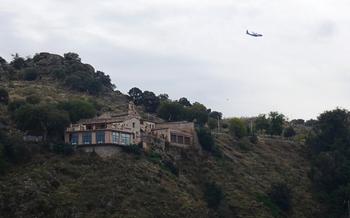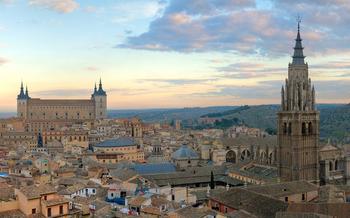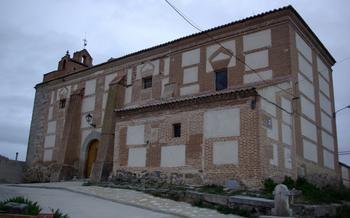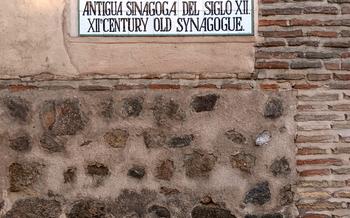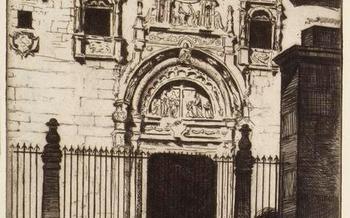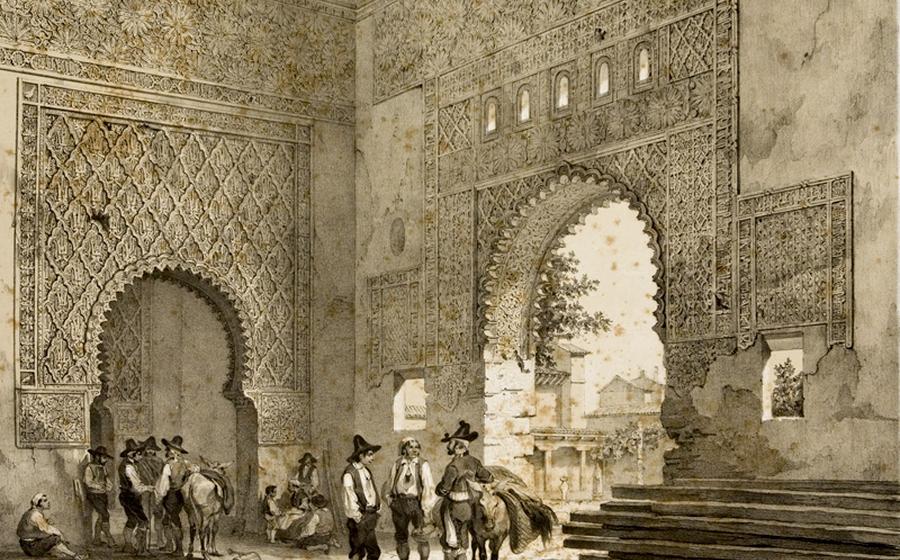
The Taller del Moro
- A City of Three Cultures
- The Taller del Moro: A Hidden Gem
- Walking the City Walls
- Discovering the Alcázar of Toledo
- Visiting the Museo del Greco
- Exploring the Plaza de Zocodover
- Strolling through the Mirador del Valle
- Sampling Local Delicacies
- Participating in Local Festivals
- Venturing Beyond Toledo
- Practical Tips for Travelers
- Insider Tip: Hidden Viewpoint
A City of Three Cultures
Toledo, a mesmerizing city nestled in the heart of Spain, proudly wears the badge of a city shaped by three distinct cultures – Christian, Muslim, and Jewish. Its rich history as a melting pot of civilizations has left an indelible mark on its architecture, culture, and spirit.
The city's strategic location on a hilltop overlooking the Tagus River made it a coveted prize throughout history. Successive waves of conquerors, from the Romans to the Visigoths, have left their imprint on Toledo's urban fabric.
The most striking testament to Toledo's multicultural heritage is its architectural wonders. The majestic Toledo Cathedral, a Gothic masterpiece, stands side by side with the intricate Mudéjar-style synagogues, remnants of the city's once-thriving Jewish community. The Alcázar, a fortress-like palace, showcases a blend of Renaissance and Moorish influences, reflecting the city's complex past.
Toledo's vibrant culture is a testament to its diverse roots. The city's cuisine, a harmonious fusion of flavors, reflects the culinary traditions of its former inhabitants. The local music and dance scene draws inspiration from both Christian and Islamic influences, creating a unique and captivating rhythm.
Must-see attractions that encapsulate Toledo's cultural fusion include the Mezquita del Cristo de la Luz, a former mosque transformed into a church, and the Puerta de Bisagra, a city gate featuring both Christian and Muslim architectural elements. These landmarks stand as living testimonies to Toledo's rich and multifaceted history.
The Taller del Moro: A Hidden Gem
Nestled in the heart of Toledo's historic Jewish Quarter, the Taller del Moro stands as a testament to the city's rich cultural heritage. Its name, meaning "Workshop of the Moor," hints at its enigmatic past, shrouded in legends and historical intrigue.
Built in the 14th century, the Taller del Moro is a unique architectural marvel, blending Islamic and Gothic styles. Its intricate brickwork facade, adorned with horseshoe arches and decorative tiles, reflects the Moorish influence that once permeated Toledo. The interior, with its vaulted ceilings and graceful columns, showcases the Gothic elegance that would come to define the city's architecture.
Legends abound regarding the Taller del Moro. One tale speaks of a Moorish craftsman who fell in love with a Christian woman and built this hidden sanctuary for their forbidden romance. Another legend tells of a Jewish family who sought refuge within its walls during times of persecution.
Today, the Taller del Moro serves as a cultural center, hosting exhibitions, concerts, and workshops that celebrate Toledo's diverse heritage. Visitors can explore its atmospheric rooms, admire the architectural details, and immerse themselves in the stories that echo within its walls.
Walking the City Walls
The city walls of Toledo, a testament to the city's rich history and strategic importance, stand as a symbol of resilience and grandeur. Constructed over centuries by different civilizations, these walls have served as a protective barrier, a defense against invaders, and a source of pride for the people of Toledo.
Strolling along the city walls is an immersive experience that offers breathtaking panoramic views of Toledo and the surrounding countryside. The walls, which stretch for approximately 5 kilometers, provide a unique perspective on the city's diverse architectural heritage, from the Alcázar to the cathedral and the Jewish Quarter.
Several starting points are available for a walk along the walls, but the most popular is the Puerta de Bisagra, a monumental gate that leads to the old city. From here, visitors can embark on a journey through time, exploring the different sections of the walls and discovering their fascinating stories.
The best time to walk the city walls is early in the morning or late in the afternoon, when the temperatures are milder and the light is more flattering for photography. Remember to wear comfortable shoes as the walk involves some uneven terrain and steps.
As you wander along the walls, take your time to soak in the stunning views and capture the essence of Toledo. The vistas from the walls are truly remarkable, offering a bird's-eye perspective of the city's landmarks, the winding streets, and the Tagus River meandering in the distance.
Don't miss the opportunity to explore the various towers and gates along the walls, each with its own unique history and architectural features. These vantage points offer different angles and perspectives of the city, making each walk a new and enriching experience.
Whether you're a history buff, an architecture enthusiast, or simply someone who loves to capture stunning views, walking the city walls of Toledo is an unforgettable experience that should not be missed.
Discovering the Alcázar of Toledo
Standing proudly on a hilltop overlooking the city, the Alcázar of Toledo is a magnificent fortress that has witnessed centuries of history. Originally built as a Roman palace in the 3rd century, the Alcázar has undergone numerous transformations, reflecting the diverse rulers who have occupied it. The Moors expanded and fortified the structure, leaving behind intricate Islamic architectural elements. After the Christian Reconquest, the Alcázar served as a royal palace and was significantly remodeled in the Gothic and Renaissance styles.
The Alcázar's imposing facade, adorned with towers and turrets, hints at its rich past. Inside, visitors can explore its various sections, including the Hall of Kings, which displays portraits of Spanish monarchs, and the Throne Room, where royal ceremonies once took place. The Alcázar also houses the Army Museum, which showcases an impressive collection of weapons, armor, and military artifacts, providing a glimpse into Toledo's military history.
A visit to the Alcázar offers a captivating journey through time, allowing visitors to trace the evolution of this architectural masterpiece and delve into the fascinating stories that have unfolded within its walls.
Visiting the Museo del Greco
The Life and Works of El Greco
Toledo is an artistic gem brimming with masterpieces, and one of its most celebrated artists is the enigmatic El Greco. Born in Crete in 1541, Domenikos Theotokopoulos, better known as El Greco, left his mark on the city with his unique style that blended Byzantine and Italian influences. His innovative approach to painting, characterized by elongated figures, vibrant colors, and dramatic lighting, earned him both admiration and controversy during his lifetime.
The Museo del Greco
To delve into the world of El Greco, a visit to the Museo del Greco is a must. Housed in a 16th-century building that once belonged to the artist's son, the museum offers a comprehensive collection of his works, providing an intimate glimpse into his artistic journey.
Highlights of the Collection
Among the highlights of the museum's collection are El Greco's iconic paintings, such as "The Burial of Count Orgaz," a masterpiece that depicts the legendary burial of a local nobleman with Christ and the Virgin Mary in attendance. Other notable works include "The Annunciation," "The Vision of Saint John," and "The Martyrdom of Saint Maurice."
Tips for Visiting
To fully appreciate El Greco's genius, consider booking a guided tour of the museum. Knowledgeable guides will provide insights into the artist's life, techniques, and the historical context of his works. The museum also hosts temporary exhibitions, so check their website for the latest offerings.
Exploring the Plaza de Zocodover
The Plaza de Zocodover is the heart and soul of Toledo, a bustling square that has witnessed centuries of history and cultural exchange. Once a marketplace and the site of bullfights, the square today is a vibrant hub of activity, surrounded by architectural marvels and exuding a lively atmosphere.
The square's rich history is reflected in its architectural ensemble. The Town Hall, with its elegant Renaissance facade, dominates one side of the square, while the Archbishop's Palace, with its Gothic and Mudejar elements, stands opposite. These buildings, along with the surrounding arcades and colorful balconies, create a harmonious blend of architectural styles that speak to Toledo's diverse past.
The Plaza de Zocodover truly comes alive in the evening when locals and tourists alike gather to soak up the vibrant atmosphere. Cafes and restaurants spill out onto the square, filling the air with the aromas of local cuisine. Street performers entertain the crowds, from musicians and dancers to magicians and acrobats. The square transforms into a stage where the city's cultural heritage is celebrated and shared.
For a taste of authentic Toledo, be sure to sample some of the local delicacies at one of the many tapas bars or restaurants in the Plaza de Zocodover. Indulge in traditional dishes like carcamusas (a stew with chickpeas and pork) or mazapan (almond marzipan), while enjoying the lively atmosphere of the square.
Whether you're shopping for souvenirs, savoring local cuisine, or simply soaking up the vibrant atmosphere, the Plaza de Zocodover is a must-visit destination in Toledo. It's a place where history, culture, and local life converge, creating a truly unforgettable experience.
Strolling through the Mirador del Valle
The Mirador del Valle is a scenic viewpoint located on the outskirts of Toledo, inviting visitors to marvel at the city's beauty from a unique perspective. With its breathtaking views of the historic city center, the winding Tagus River, and the surrounding countryside, the Mirador del Valle offers a moment of tranquility and escape from the bustling streets of Toledo.
Strolling through the Mirador del Valle is a delightful experience, allowing you to soak in the panoramic vistas and appreciate the city's rich history and architecture. The viewpoint boasts well-maintained gardens with colorful flowers, shady trees, and comfortable benches, providing a relaxing haven to unwind and contemplate the scenery.
One of the highlights of the Mirador del Valle is the Mirador de la Virgen del Valle, a viewpoint dedicated to the patron saint of Toledo. Here, visitors can admire a stunning statue of the Virgin Mary and a cross overlooking the city, creating a picturesque backdrop for photographs.
For those seeking a more active experience, the Mirador del Valle offers hiking trails that lead to the riverbanks and surrounding hills, providing opportunities for exploration and adventure. Along the way, you can discover hidden corners, encounter local wildlife, and capture breathtaking views of Toledo from different angles.
Whether you're a history buff, a nature enthusiast, or simply seeking a peaceful retreat, the Mirador del Valle is a must-visit destination for anyone exploring Toledo. Take your time to wander through the gardens, soak in the panoramic views, and enjoy the tranquility of this hidden gem.
Sampling Local Delicacies
Toledo's culinary traditions are a testament to its rich history and cultural influences. Must-try dishes include carcamusas, a hearty chickpea stew, and mazapán, a sweet treat made from almonds and honey. Don't miss the opportunity to sample queso manchego, a world-renowned sheep's milk cheese produced in the region. For a taste of local cuisine, head to traditional restaurants in the old town, where you can savor authentic recipes passed down through generations.
Among the local specialties, toledana partridge stands out, a game bird dish prepared with a variety of spices and herbs. For a unique culinary experience, try sopa castellana, a traditional garlic soup with bread and egg. Vegetarian options are also available, such as migas manchegas, a dish made with breadcrumbs, garlic, and olive oil.
To enhance your culinary adventure, participate in a cooking class and learn the secrets of Toledo's cuisine. Discover the art of preparing traditional dishes using fresh, local ingredients. Whether you're a seasoned cook or a novice, these classes offer a hands-on experience and a deeper appreciation for the region's gastronomy.
Participating in Local Festivals
Toledo is renowned for its vibrant and colorful festivals, which showcase the city's rich cultural heritage and traditions. Among the most popular festivals is the Corpus Christi procession, held in late spring or early summer. This elaborate religious procession features ornate floats, traditional costumes, and street performers, creating a mesmerizing spectacle that attracts visitors from all over the world.
Another highlight is the Toledan Patios Festival, held in May, where private courtyards and patios are adorned with flowers and decorations, creating a magical and enchanting atmosphere. Visitors can wander through the city's hidden courtyards, admiring the beautiful displays and experiencing the warm hospitality of the locals.
For music lovers, the Toledo International Music Festival in July offers a diverse lineup of classical and contemporary concerts, featuring renowned musicians and orchestras from around the world. The festival takes place in various historic venues throughout the city, creating a unique and intimate ambiance for music enthusiasts.
To immerse yourself in the city's medieval past, don't miss the Medieval Market held in October. This lively festival transports visitors back in time with its colorful stalls selling traditional crafts, food, and beverages, as well as performances of medieval music, dance, and theater.
Participating in these local festivals is a fantastic way to experience the true essence of Toledo, connect with the local community, and create lasting memories of your visit to this captivating city.
Venturing Beyond Toledo
Toledo's captivating allure extends beyond its city limits, inviting travelers to explore the surrounding region, steeped in history, culture, and natural beauty. venturing just a short distance from the city unveils a tapestry of charming towns and villages, each possessing unique stories and attractions.
Consuegra, a picturesque village perched atop a hill, beckons with its iconic windmills, reminiscent of the iconic novel "Don Quixote". Stroll through its cobblestone streets, marvel at the preserved medieval castle, and soak in the panoramic views of La Mancha's vast plains.
Aranjuez, a former royal residence, enchants visitors with its opulent Royal Palace, surrounded by sprawling gardens and tranquil waterways. Explore the meticulously manicured grounds, wander through the verdant groves, and discover the hidden fountains and sculptures that grace this enchanting retreat.
The region surrounding Toledo is a treasure trove of natural wonders, offering a respite from the city's vibrant energy. Hike through the picturesque Cabañeros National Park, where rugged landscapes, abundant wildlife, and ancient rock formations create a breathtaking symphony of nature.
For a unique perspective, embark on a hot-air balloon ride over the region, soaring above the rolling hills, vineyards, and olive groves that define the Castilian countryside. Witness the sunrise or sunset bathe the landscape in a warm glow, creating a truly unforgettable experience.
Practical Tips for Travelers
Planning Your Trip:
- Best time to visit: Spring (April-May) and autumn (September-October) offer pleasant weather for exploring the city.
- Accommodation: Toledo has a range of accommodation options, from budget hostels to luxury hotels. Book in advance, especially during peak season.
- Transportation: Toledo is well-connected by train and bus to Madrid and other cities. The historic center is best explored on foot.
Exploring Toledo:
- Suggested itinerary:
- Day 1: Visit the Alcázar, the Toledo Cathedral, and the Museo del Greco.
- Day 2: Explore the Jewish Quarter, walk along the city walls, and enjoy the vibrant atmosphere of the Plaza de Zocodover.
- Day 3: Take a day trip to nearby Consuegra to see the iconic windmills, or visit the royal palace and gardens of Aranjuez.
- Cultural customs: Dress respectfully when visiting religious sites. Greetings are typically accompanied by a kiss on each cheek.
Insider Tip:
- Secret viewpoint: For breathtaking panoramic views of the city, head to the Mirador del Valle Gardens. Capture stunning photos, especially during golden hour.
Insider Tip: Hidden Viewpoint
Unveiling a Secret Panorama:
Beyond the well-trodden paths of Toledo lies a hidden viewpoint that unveils the city's captivating beauty from a unique perspective. Tucked away from the crowds, this secret spot offers a breathtaking panorama that will leave you spellbound.
To reach this hidden gem, take a leisurely stroll along the Paseo de Recaredo, a scenic promenade that hugs the banks of the Tagus River. As you meander through the park, keep an eye out for a small, unassuming path that branches off to the left, leading uphill. Follow this path, and you will soon find yourself at the foot of a hill crowned by a cluster of ancient cypress trees.
Ascend the hill, taking in the panoramic vistas that gradually unfold before you. The city of Toledo, with its iconic skyline dominated by the majestic Toledo Cathedral, stretches out before you, bathed in a golden glow. The Tagus River meanders through the landscape, creating a serpentine ribbon that adds to the picturesque scene.
The best time to visit this hidden viewpoint is during the golden hour, just before sunset. As the sun dips towards the horizon, the sky erupts in a vibrant tapestry of colors, casting a magical aura over the city. Capture this fleeting moment with your camera to immortalize the breathtaking beauty of Toledo.
Remember to tread lightly and respect the tranquility of this hidden gem. Avoid disturbing the local wildlife and refrain from leaving any trace of your visit. Embrace the opportunity to connect with the authentic essence of Toledo, far from the madding crowds, and cherish the memories of this unforgettable experience.




